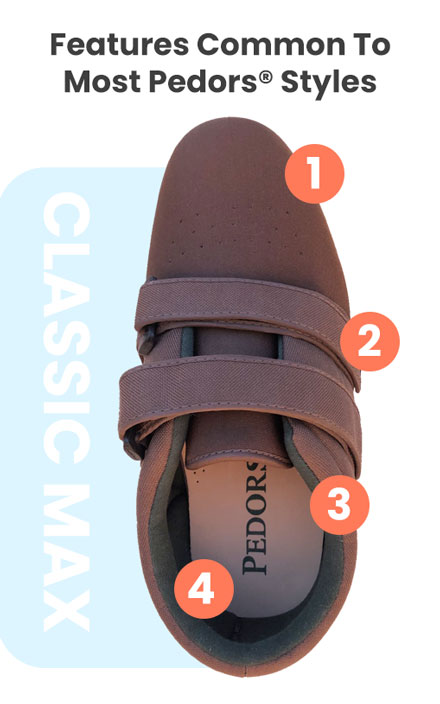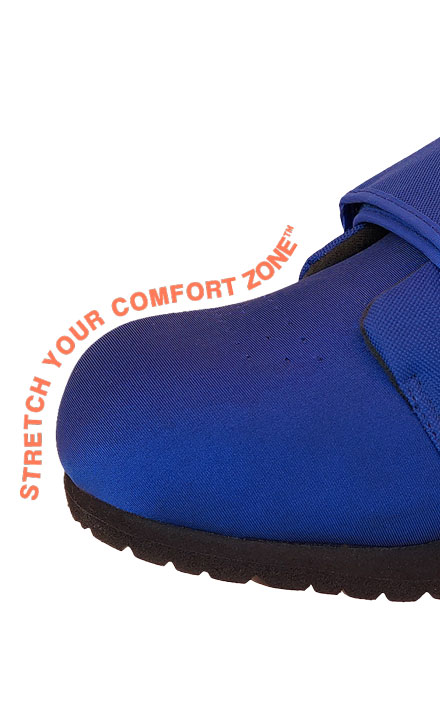Weekend Sale! Save 20% Code: WEEKEND20


If you suffer with swollen feet and ankles and want to be comfortable wearing shoes again, then please take a few moments to consider trying Pedors. Our high-quality stretch footwear with wide toe-boxes have helped tens of thousands of people just like you find comfort again.
We offer free shipping and return shipping so that you can see for yourself. Simply order whatever shoes you like and then try on in the comfort of your home.
For sizing advice we have a full guide here or alternatively you can use the sizing cards found on each category page. They give you a quick guide on what shoes may be suitable for your swollen feet.
If you have any questions, please don’t hesitate to contact Pedors on 1-800-750-6729 or email support@pedors.com
Popular Products on Pedors.com
The best shoes for swollen feet feature ajustable closures, stretch uppers and are available in many widths.
For mildly swollen feet (Medium and wide widths) we suggest:
For moderate to very swollen feet (X-Wide to XXX-Wide) we suggest:
For the most severely swollen feet (XXXXX-Wide +) we suggest:
The best shoes for swollen diabetic feet have the following features:
For mildly swollen diabetic feet (Medium and wide widths) we suggest:
For moderate to very swollen diabetic feet (X-Wide to XXX-Wide) we suggest:
For the most severely swollen diabetic feet (XXXXX-Wide +) we suggest:
The best shoes for swollen feet during pregnancy would be a comfortable pair of stretch shoes that are easy to get on and are adjustable. Your feet will most likely swell more in the late afternoon and so having stretch uppers and ajustable closures will enable you ajust the fit.
For expectant mothers who have extremely swollen feet, the Pedors MAX Slides would be suitable (XXX-Wide width):
The best shoes for swollen feet after surgery would be easy to get on, be adjustable and offer protection. Also they may have a stretch feature which would allow for when the swelling goes up or down, or for when the volume of bandaging increases or decreases
The following styles meet all of the above criteria:
The best shoes for swollen feet for the elderly would be light-weight, feature ajustable closures, stretch uppers and are available in many widths.
For mildly swollen feet (Medium and wide widths) we suggest:
For moderate to very swollen feet (X-Wide to XXX-Wide) we suggest:
For the most severely swollen feet (XXXXX-Wide +) we suggest:
Recently Added

Pedors Shoes For Swollen Feet was founded in 1997 by brothers Stephen and John O'Hare. Based out of Marietta, Georgia near Atlanta, the two ex-pat Englishmen set out to change the way people viewed and used orthopedic shoes. The concept was simple; rather than use heavy leather like everyone else, the O’Hares decided to use a heat-moldable stretch material for the uppers (which they later named Pedoprene) along with light-weight materials for the rest of the shoes.
Other important features that set them apart? The shoes were machine washable and had removable insoles so that people could put their own custom, or off-the-shelf orthotics in the shoes when needed.
When the company first launched with the Pedors Classic, the main push was towards solving the issues people had with painful arthritic feet. The soft stretchy uppers of the shoes worked perfectly for people with sore toe joints, bunions and corns.
It wasn’t long into their journey however when the brothers discovered that the Classics were also ideal shoes for diabetics. Those same soft and stretchy uppers helped to reduce rubbing and abrasions, which in-turn resulted in less blistering and therefore less ulceration of the diabetic foot. That’s when the little shoe company took off!
As the years went by, more and more customers requested that Pedors make wider and wider shoes to accommodate not only their bunions, hammer toes and other forefoot problems, but also their swollen feet. So the brothers made the decision to offer their Classic lines of shoes in super-wide 4E and 6E widths. It was a gamble that paid off! That’s when the little shoe company went stratospheric and started to pick up industry awards like the one shown here.
Today Pedors offers shoes for swollen feet in general, Edema and Lymphedema. The shoes are worn by people with diabetes, arthritis and all manner of forefoot issues too.
Launched in September 2023 the Pedors Super-MAX shoes, available in a 10E width, which is the equivalent of XXXXX-Wide (!) have been an amazing hit!
This website is divided into three main categoiries women's shoes, men's shoes and orthotics / insoles.
Not sure where to start? A good place would be by looking to see if we have a step-by-step guide available for your foot condition, the most popular one being our shoes for swollen feet guide: Swollen Feet Shoes Step-by-Step Guide, our Shoes For Swollen Feet for Women Guide or our Shoes For Swollen Feet For Men Guide.
To determine your correct size for Pedors shoes, please visit our sizing guide.

Hi there, I’m John O’Hare co-founder and webmaster of Pedors Shoes. You will run into me throughout the website and by email should have questions or order shoes. If you do have any questions, please don’t hesitate to contact me at support@pedors.com.
For those interested, this picture was taken in Rome Italy on my honeymoon over a decade ago. I don’t look quite like that now, but I do like the picture!